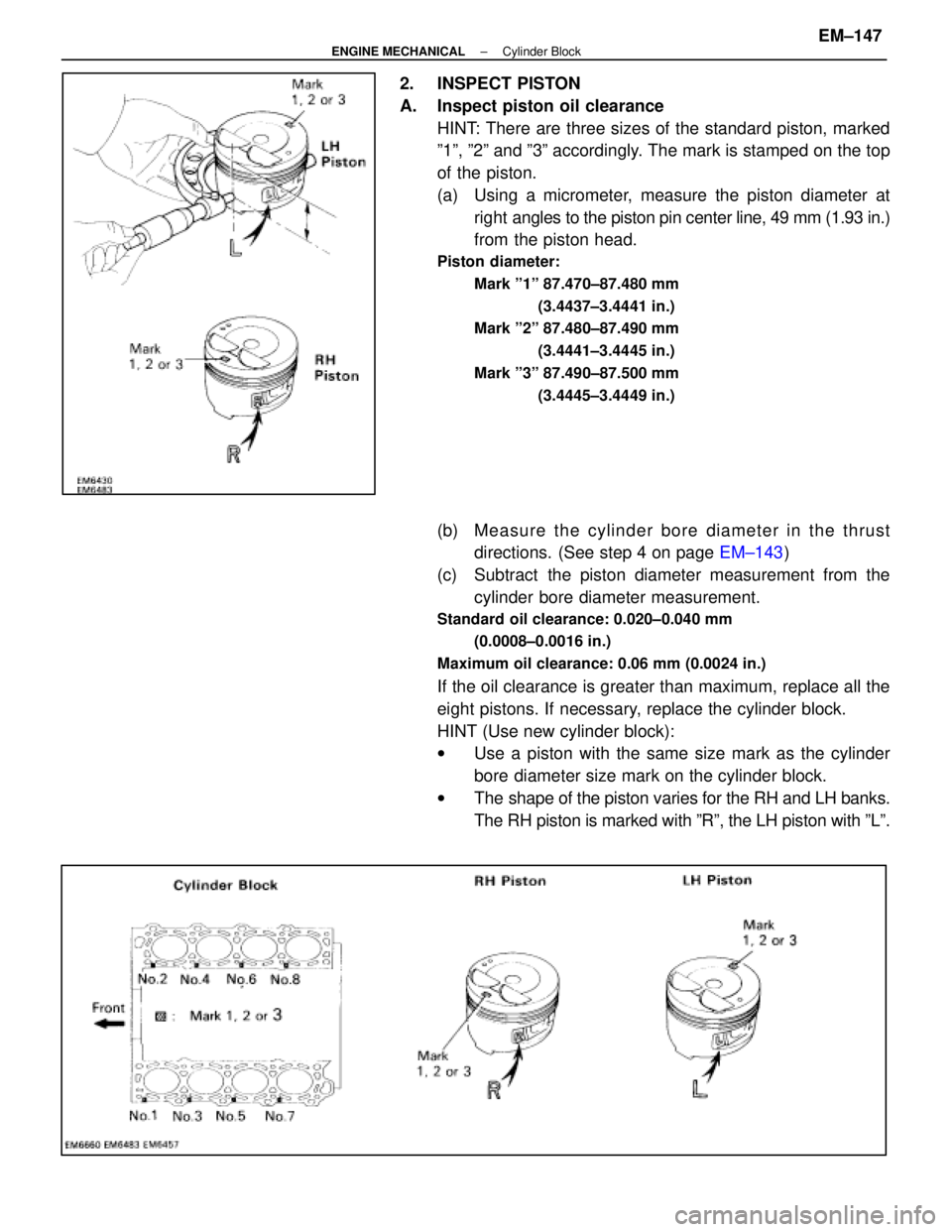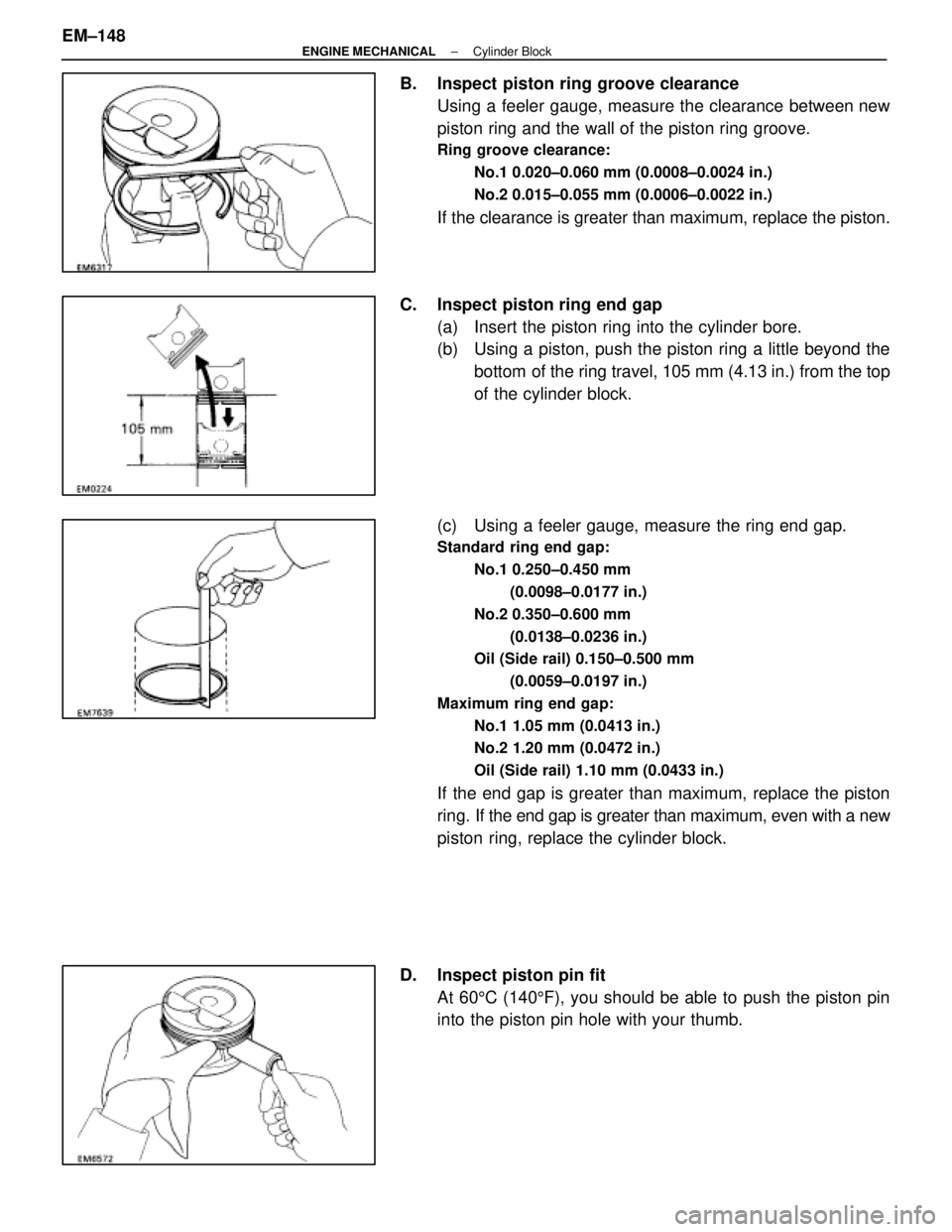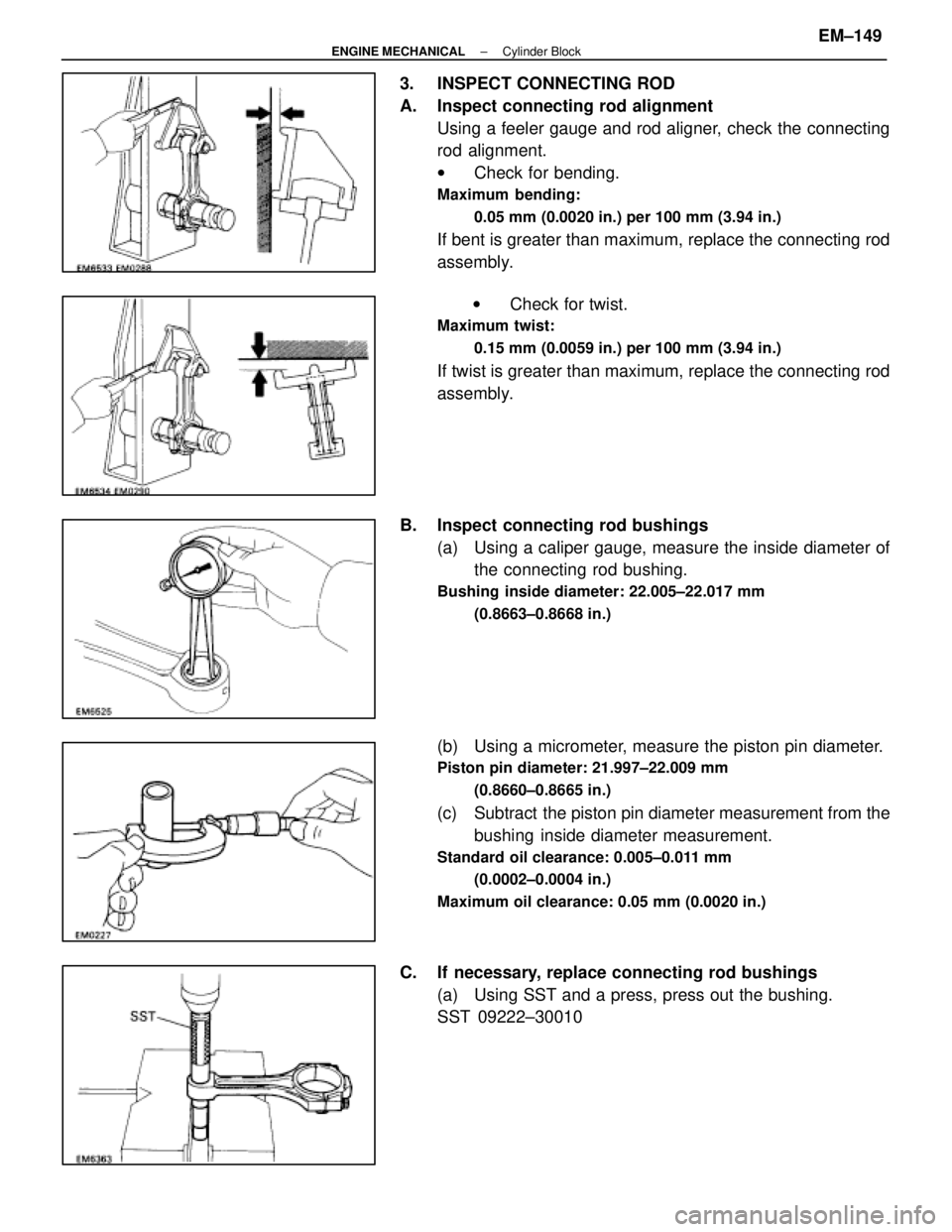Page 1608 of 4087
3. INSPECT CYLINDER FOR VERTICAL SCRATCHESVisually check the cylinder for vertical scratches.
If deep scratches are present, replace the cylinder block.
4. INSPECT CYLINDER BORE DIAMETER HINT: There are three sizes of the standard cylinder bore di-
ameter, marked º1º, º2º and º3º accordingly. The marked is
stamped on the top of the cylinder block.
Using a cylinder gauge, measure the cylinder bore diameter
at positions A, B and C in the thrust and axial directions.
Standard diameter:
Mark º1º 87.500±87.510 mm (3.4449±3.4453 in.)
Mark º2º 87.510±87.520 mm (3.4453±3.4457 in.)
Mark º3º 87.520±87.530 mm (3.4457±3.4461 in.)
Maximum diameter: 87.73 mm (3.4539 in.)
If the diameter is greater than maximum, replace the cylinder
block.
5. REMOVE CYLINDER RIDGE If the wear is less than 0.2 mm (0.008 in.), using a ridge ream-
er, grind the top of the cylinder.
±
ENGINE MECHANICAL Cylinder BlockEM±143
WhereEverybodyKnowsYourName
Page 1609 of 4087

6. INSPECT MAIN BEARING CAP STUD BOLTSUsing a vernier caliper, measure the tension portion diameter
of the stud bolt.
Standard diameter: 7.500±7.600 mm
(0.2953±0.2992 in.)
Minimum diameter: 7.40 mm (0.2913 in.)
If the diameter is less than minimum, replace the stud bolt.
7. IF NECESSARY, REPLACE MAIN BEARING CAP STUD BOLTS
(a) Using the two main bearing cap nuts, remove the studbolt.
(b) Apply a light coat of engine oil on the threads and under
the flange of the stud bolt.
(c) Using the two main bearing cap nuts, install and torque
the stud bolt.
Torque: 10 N Vm (100 kgf Vcm, 7 ft Vlbf)
HINT: Stud bolts come in lengths of 90.0 mm (3.543 in.) and
101.5 mm (3.996 in.). Install the 101.5 mm (3.996 in.) bolts
in inside positions. Install the 90.0 mm (3.543 in.) bolts in out-
side positions.
DISASSEMBLY OF PISTON AND
CONNECTING ROD ASSEMBLIES
1. CHECK FIT BETWEEN PISTON AND PISTON PIN
Try to move the piston back and forth on the piston pin.
If any movement is felt, replace the piston and pin as a set.
EM±144
±
ENGINE MECHANICAL Cylinder Block
WhereEverybodyKnowsYourName
Page 1610 of 4087
2. REMOVE PISTON RINGS(a) U s i n g a p i s t o n r i n g e x pander, remove the two
compression rings.
(b) Remove the two side rails and oil ring expander by hand.
HINT: Arrange the piston rings in correct order only.
3. DISCONNECT CONNECTING ROD FROM PISTON (a) Using a small screwdriver, pry out the two snap rings.
(b) Gradually heat the piston to approx. 60 °C (140 °F).
(c) Using a plastic±face hammer and brass bar, lightly tap out the piston pin and remove the connecting rod.
±
ENGINE MECHANICAL Cylinder BlockEM±145
WhereEverybodyKnowsYourName
Page 1611 of 4087
HINT:
wThe piston and pin are a matched set.
w Arrange the pistons, pins, rings, connecting rods and
bearings in correct order.
INSPECTION OF PISTON AND
CONNECTING ROD ASSEMBLIES
1. CLEAN PISTON
(a) Using a gasket scraper, remove the carbon from thepiston top.
(b) Using a groove cleaning tool or broken ring, clean the piston ring grooves.
(c) Using solvent and a brush, thoroughly clean the piston.
NOTICE: Do not use a wire brush.
EM±146
±
ENGINE MECHANICAL Cylinder Block
WhereEverybodyKnowsYourName
Page 1612 of 4087

2. INSPECT PISTON
A. Inspect piston oil clearanceHINT: There are three sizes of the standard piston, marked
º1º, º2º and º3º accordingly. The mark is stamped on the top
of the piston.
(a) Using a micrometer, measure the piston diameter atright angles to the piston pin center line, 49 mm (1.93 in.)
from the piston head.
Piston diameter:
Mark º1º 87.470±87.480 mm (3.4437±3.4441 in.)
Mark º2º 87.480±87.490 mm
(3.4441±3.4445 in.)
Mark º3º 87.490±87.500 mm (3.4445±3.4449 in.)
(b) Me a su re th e cyli nder bore diameter in the thrust
directions. (See step 4 on page EM±143)
(c) Subtract the piston diameter measurement from the cylinder bore diameter measurement.
Standard oil clearance: 0.020±0.040 mm
(0.0008±0.0016 in.)
Maximum oil clearance: 0.06 mm (0.0024 in.)
If the oil clearance is greater than maximum, replace all the
eight pistons. If necessary, replace the cylinder block.
HINT (Use new cylinder block):
w Use a piston with the same size mark as the cylinder
bore diameter size mark on the cylinder block.
w The shape of the piston varies for the RH and LH banks.
The RH piston is marked with ºRº, the LH piston with ºLº.
±
ENGINE MECHANICAL Cylinder BlockEM±147
WhereEverybodyKnowsYourName
Page 1613 of 4087

B. Inspect piston ring groove clearanceUsing a feeler gauge, measure the clearance between new
piston ring and the wall of the piston ring groove.
Ring groove clearance:
No.1 0.020±0.060 mm (0.0008±0.0024 in.)
No.2 0.015±0.055 mm (0.0006±0.0022 in.)
If the clearance is greater than maximum, replace the piston.
C. Inspect piston ring end gap (a) Insert the piston ring into the cylinder bore.
(b) Using a piston, push the piston ring a little beyond thebottom of the ring travel, 105 mm (4.13 in.) from the top
of the cylinder block.
(c) Using a feeler gauge, measure the ring end gap.
Standard ring end gap: No.1 0.250±0.450 mm(0.0098±0.0177 in.)
No.2 0.350±0.600 mm (0.0138±0.0236 in.)
Oil (Side rail) 0.150±0.500 mm
(0.0059±0.0197 in.)
Maximum ring end gap: No.1 1.05 mm (0.0413 in.)
No.2 1.20 mm (0.0472 in.)
Oil (Side rail) 1.10 mm (0.0433 in.)
If the end gap is greater than maximum, replace the piston
ring. If the end gap is greater than maximum, even with a new
piston ring, replace the cylinder block.
D. Inspect piston pin fit At 60 5C (140 5F), you should be able to push the piston pin
into the piston pin hole with your thumb.
EM±148
±
ENGINE MECHANICAL Cylinder Block
WhereEverybodyKnowsYourName
Page 1614 of 4087

3. INSPECT CONNECTING ROD
A. Inspect connecting rod alignmentUsing a feeler gauge and rod aligner, check the connecting
rod alignment.
wCheck for bending.
Maximum bending:
0.05 mm (0.0020 in.) per 100 mm (3.94 in.)
If bent is greater than maximum, replace the connecting rod
assembly.
w Check for twist.
Maximum twist:
0.15 mm (0.0059 in.) per 100 mm (3.94 in.)
If twist is greater than maximum, replace the connecting rod
assembly.
B. Inspect connecting rod bushings (a) Using a caliper gauge, measure the inside diameter ofthe connecting rod bushing.
Bushing inside diameter: 22.005±22.017 mm
(0.8663±0.8668 in.)
(b) Using a micrometer, measure the piston pin diameter.
Piston pin diameter: 21.997±22.009 mm(0.8660±0.8665 in.)
(c) Subtract the piston pin diameter measurement from thebushing inside diameter measurement.
Standard oil clearance: 0.005±0.011 mm
(0.0002±0.0004 in.)
Maximum oil clearance: 0.05 mm (0.0020 in.)
C. If necessary, replace connecting rod bushings (a) Using SST and a press, press out the bushing.
SST 09222±30010
±
ENGINE MECHANICAL Cylinder BlockEM±149
WhereEverybodyKnowsYourName
Page 1615 of 4087
(b) Align the oil holes of the connecting rod and a newbushing.
(c) Using SST and a press, press in the bushing.
SST 09222±30010
(d) Using a pin hole grinder, hole the bushing to obtain the standard specified clearance (see step B above)
between the bushing and piston pin.
(e) Check the piston pin fit at normal room temperature.
Coat the piston pin with engine oil, and push it into the con-
necting rod with your thumb.
D. Inspect connecting rod bolts Using a vernier caliper, measure the tension portion diameter
of the bolt.
Standard diameter: 7.200±7.300 mm
(0.2835±0.2874 in.)
Minimum diameter: 7.00 mm (0.2756 in.)
If the outside diameter is less than minimum, replace the bolt.
EM±150
±
ENGINE MECHANICAL Cylinder Block
WhereEverybodyKnowsYourName